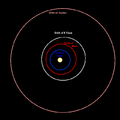8 Flora facts for kids

Size comparison: the first 10 asteroids profiled against Earth's Moon. Flora is third from the right.
|
|
| Discovery | |
|---|---|
| Discovered by | J.R. Hind |
| Discovery date | October 18, 1847 |
| Designations | |
| none | |
| Main belt (Flora family) | |
| Orbital characteristics | |
| Epoch November 26, 2005 (JD 2453700.5) | |
| Aphelion | 380.850 Gm (2.546 AU) |
| Perihelion | 277.995 Gm (1.858 AU) |
| 329.422 Gm (2.202 AU) | |
| Eccentricity | 0.1561 |
| 1193.549 d (3.27 a) | |
|
Average orbital speed
|
19.95 km/s |
| 156.401° | |
| Inclination | 5.886° |
| 111.011° | |
| 285.128° | |
| Physical characteristics | |
| Dimensions | 145×145×120 km |
| Mass | ~3.6×1018 kg |
|
Mean density
|
~2.7 g/cm³ |
| ~0.045 m/s² | |
| ~0.081 km/s | |
| 0.5363 d (12.87 h) | |
| Albedo | 0.243 (geometric) |
| Temperature | ~180 K max: 276 K (+3 °C) |
|
Spectral type
|
S-type asteroid |
| 7.9 to 11.6 | |
| 6.49 | |
| 0.21" to 0.053" | |
8 Flora is a big, bright, main belt asteroid. It is the closest big asteroid: no asteroid closer to the Sun has a diameter above 25 kilometres or two-elevenths that of Flora itself, and not until the tiny 149 Medusa was found was a single asteroid orbiting at a closer mean distance known. It is the seventh brightest asteroid with a mean opposition magnitude of +8.7. Flora can reach a magnitude of +7.9 at a favorable opposition near perihelion, such as will occur in mid November 2007.
Discovery and naming
Flora was found by J. R. Hind on October 18, 1847. It was his second asteroid discovery after 7 Iris.
The name Flora was proposed by John Herschel, from Flora, the Latin goddess of flowers and gardens, wife of Zephyrus (the personnification of the West wind), mother of Spring, and whose Greek equivalent is Chloris (who has her own asteroid, 410 Chloris).
Characteristics
Flora is the parent body of the Flora family of asteroids, and by far the biggest member, having about 80% of the total mass of this family. But Flora was almost certainly disrupted by the impact(s) that formed the family, and is probably an aggregate of most of the pieces.
Flora's spectrum indicates that its surface is made of a mixture of silicate rock (including pyroxene and olivine) and nickel-iron metal. Flora, and the whole Flora family generally, are good candidates for being the parent bodies of the L chondrite meteorites. This meteorite type comprises about 38% of all meteorites impacting the Earth.
Notable facts
During an observation on March 25, 1917, 8 Flora was mistaken for the star TU Leonis, which led to that star's classification as a U Geminorum cataclysmic variable star. This mistake was uncovered only in 1995.
— Horizons can be used to obtain a current ephemeris.
Images for kids
See also
 In Spanish: (8) Flora para niños
In Spanish: (8) Flora para niños


